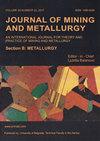Removal of arsenic from liquid blister copper during remelting in an induction vacuum furnace
IF 1
4区 材料科学
Q3 METALLURGY & METALLURGICAL ENGINEERING
Journal of Mining and Metallurgy Section B-Metallurgy
Pub Date : 2021-01-01
DOI:10.2298/jmmb210108033l
引用次数: 0
Abstract
Using a reduced pressure during the smelting and refining of alloys removes dissolved gasses, as well as impurities with a high vapor pressure. When smelting is carried out in vacuum induction furnaces, the intensification of the discussed processes is achieved by intensive mixing of the bath, as well as an enhanced mass exchange surface (liquid metal surface) due to the formation of a meniscus. This is due to the electromagnetic field applied to the liquid metal. This study reports the removal of arsenic from blister copper via refining in an induction vacuum furnace in the temperature range of 1423-1523 K, at operating pressures from 8 to 1333 Pa. The overall mass transfer coefficient kAs determined from the experimental data ranged from 9.99?10-7 to 1.65?10-5 ms-1. Arsenic elimination was largely controlled by mass transfer in the gas phase. The kinetic analysis indicated that the arsenic evaporation rate was controlled by the combination of both liquid and gas-phase mass transfer only at a pressure of 8 Pa.感应真空炉重熔铜液中砷的去除
在合金的冶炼和精炼过程中使用减压去除溶解的气体,以及高蒸气压的杂质。当熔炼在真空感应炉中进行时,所讨论的过程的强化是通过强化熔液的混合,以及由于形成半月板而增强的质量交换表面(液态金属表面)来实现的。这是由于施加在液态金属上的电磁场。本研究报告了在温度范围为1423-1523 K,操作压力为8 - 1333 Pa的感应真空炉中,通过精炼从泡铜中去除砷。由实验数据确定的总传质系数ka范围为9.99?10-7到1.65?纯ms-1。砷的消除主要由气相的传质控制。动力学分析表明,只有在压力为8 Pa时,砷的蒸发速率是由液相和气相传质共同控制的。
本文章由计算机程序翻译,如有差异,请以英文原文为准。
求助全文
约1分钟内获得全文
求助全文
来源期刊
CiteScore
2.00
自引率
40.00%
发文量
19
审稿时长
2 months
期刊介绍:
University of Belgrade, Technical Faculty in Bor, has been publishing the journal called Journal of Mining and Metallurgy since 1965 and in 1997 it was divided in two independent journals dealing with mining and metallurgy separately. Since 2009 Journal of Mining and Metallurgy, Section B: Metallurgy has been accepted in Science Citation Index Expanded.
Journal of Mining and Metallurgy, Section B: Metallurgy presents an international medium for the publication of contributions on original research which reflect the new progresses in theory and practice of metallurgy. The Journal covers the latest research in all aspects of metallurgy including hydrometallurgy, pyrometallurgy, electrometallurgy, transport phenomena, process control, solidification, mechanical working, solid state reactions, materials processing, surface treatment and relationships among processing, structure, and properties of materials.

 求助内容:
求助内容: 应助结果提醒方式:
应助结果提醒方式:


